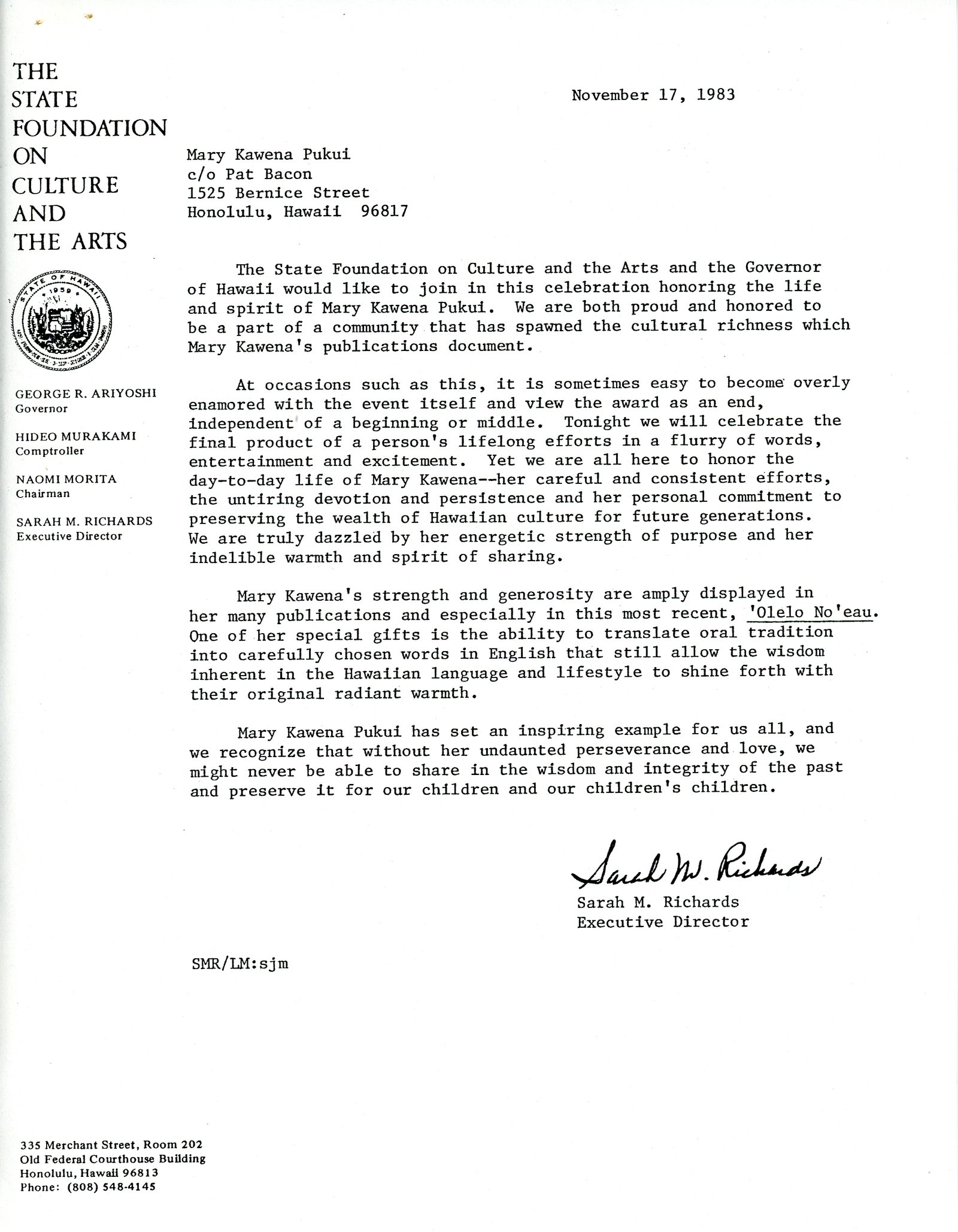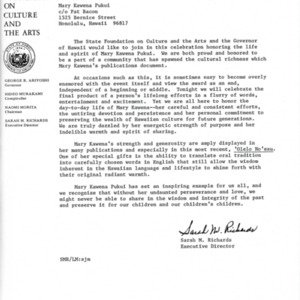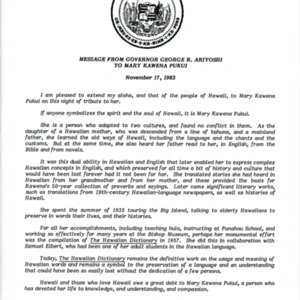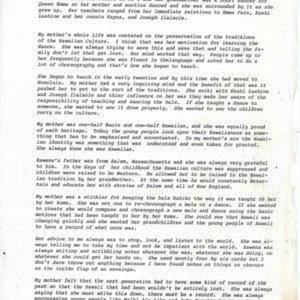Mary Abigail Kawena‘ulaokalanihi‘iakaikapoliopelekawahine‘aihonua Wiggin Pukū‘i
Title
Mary Abigail Kawena‘ulaokalanihi‘iakaikapoliopelekawahine‘aihonua Wiggin Pukū‘i
Description
Mary Abigail Kawena‘ulaokalanihi‘iakaikapoliopelekawahineʻaihonua Wiggin Pūku‘i
Mary Pūkuʻi, a living treasure of Hawaii, has published many books illuminating the Hawaiian culture. Among them is the Hawaiian Dictionary which she completed in 1957 with Dr. Samuel Elbert. Mentor of hula exponents such as the late ‘lolani Luahine and Lokalia Montgomery, she is widely recognized as the premier resource of the Hawaiian culture. Because of health problems, Mrs. Pūku‘i consented to having her daughter, Mrs. Pat Bacon, share her story with everyone.
Kawena was born and raised in Ka‘u and her grandmother was a court dancer for Queen Emma so her mother and aunties danced and she was surrounded by it as she grew up. Her teachers ranged from her immediate relatives to Emma Fern, Keahi Luahine and her cousin Kapua, and Joseph ʻĪlālāʻole.
Kawena’s father was from Salem, Massachusetts. She has always been grateful to him for allowing her to be raised Hawaiian by her grandmother. At the same time he would constantly entertain and educate her with stories of Salem and all of New England. In the days of her childhood, Hawaiian culture was suppressed and children were raised in the Western culture.
My kahu hānai was one-half Haole and one-half Hawaiian, and was equally proud of each heritage. Today the young people look upon their Hawaiianess as something that has to be emphasized and accentuated. In my mother’s era the Hawaiian identity was something that was understood and even taken for granted. She always knew she was Hawaiian.
Her whole life was centered on the preservation of the traditions of the Hawaiian culture. I think that was her motivation for learning the dance. She was always trying to save this and save that by telling the family don’t let that get lost. Her mind worked that way. People came up to her frequently because she was fluent in the language and asked her to do a lot of choreography and that’s how she began to teach.
She began to teach in the early Twenties. By this time she had moved to Honolulu. My mother had a very inquiring mind and the benefit of that was it pushed her to get to the root of the traditions. She graduated traditionally with Keahi Luahine and Joseph ʻĪlālāʻole, and their influence on her was that they made her aware of the responsibility of teaching and dancing the hula. If she taught a dance to someone she wanted to see it done properly. She wanted to see the children carry on the culture.
Kawena was a stickler for keeping the hula kahiko the way it was taught to her by her kumu. She was not one to rechoreograph a mele or a dance. If she wanted to create she would compose and choreograph a new mele and dance using the basic motions that had been taught to her by her kumu. She could see that Hawai‘i was changing quickly and she wanted her grandchildren and the young people of Hawai‘i to have a record of what once was.
Her advice to me always was to stop, look, and listen. She was always telling me to take my time and not be impatient. Kawena was always writing and scribbling notes wherever she was, whatever she was doing, on whatever she could get her hands on. She used mostly four by six cards but I don’t dare throw out anything because I have found notes on things as obscure as the inside flap of an envelope.
My mother felt that the next generation had to have some kind of record of the past so that the Hawai‘i that had been wouldn’t be entirely lost. She was always saying that she must write this down, there must be a record. She was always encouraging young people like Mā‘iki Aiu Lake and John Topolinski to read and write down everything in regards to Hawaiian culture because if one depends upon their memory, in time it will fade.
Mary Pūkuʻi, a living treasure of Hawaii, has published many books illuminating the Hawaiian culture. Among them is the Hawaiian Dictionary which she completed in 1957 with Dr. Samuel Elbert. Mentor of hula exponents such as the late ‘lolani Luahine and Lokalia Montgomery, she is widely recognized as the premier resource of the Hawaiian culture. Because of health problems, Mrs. Pūku‘i consented to having her daughter, Mrs. Pat Bacon, share her story with everyone.
Kawena was born and raised in Ka‘u and her grandmother was a court dancer for Queen Emma so her mother and aunties danced and she was surrounded by it as she grew up. Her teachers ranged from her immediate relatives to Emma Fern, Keahi Luahine and her cousin Kapua, and Joseph ʻĪlālāʻole.
Kawena’s father was from Salem, Massachusetts. She has always been grateful to him for allowing her to be raised Hawaiian by her grandmother. At the same time he would constantly entertain and educate her with stories of Salem and all of New England. In the days of her childhood, Hawaiian culture was suppressed and children were raised in the Western culture.
My kahu hānai was one-half Haole and one-half Hawaiian, and was equally proud of each heritage. Today the young people look upon their Hawaiianess as something that has to be emphasized and accentuated. In my mother’s era the Hawaiian identity was something that was understood and even taken for granted. She always knew she was Hawaiian.
Her whole life was centered on the preservation of the traditions of the Hawaiian culture. I think that was her motivation for learning the dance. She was always trying to save this and save that by telling the family don’t let that get lost. Her mind worked that way. People came up to her frequently because she was fluent in the language and asked her to do a lot of choreography and that’s how she began to teach.
She began to teach in the early Twenties. By this time she had moved to Honolulu. My mother had a very inquiring mind and the benefit of that was it pushed her to get to the root of the traditions. She graduated traditionally with Keahi Luahine and Joseph ʻĪlālāʻole, and their influence on her was that they made her aware of the responsibility of teaching and dancing the hula. If she taught a dance to someone she wanted to see it done properly. She wanted to see the children carry on the culture.
Kawena was a stickler for keeping the hula kahiko the way it was taught to her by her kumu. She was not one to rechoreograph a mele or a dance. If she wanted to create she would compose and choreograph a new mele and dance using the basic motions that had been taught to her by her kumu. She could see that Hawai‘i was changing quickly and she wanted her grandchildren and the young people of Hawai‘i to have a record of what once was.
Her advice to me always was to stop, look, and listen. She was always telling me to take my time and not be impatient. Kawena was always writing and scribbling notes wherever she was, whatever she was doing, on whatever she could get her hands on. She used mostly four by six cards but I don’t dare throw out anything because I have found notes on things as obscure as the inside flap of an envelope.
My mother felt that the next generation had to have some kind of record of the past so that the Hawai‘i that had been wouldn’t be entirely lost. She was always saying that she must write this down, there must be a record. She was always encouraging young people like Mā‘iki Aiu Lake and John Topolinski to read and write down everything in regards to Hawaiian culture because if one depends upon their memory, in time it will fade.
Citation
“Mary Abigail Kawena‘ulaokalanihi‘iakaikapoliopelekawahine‘aihonua Wiggin Pukū‘i,” Nā Kumu Hula Archive, accessed August 31, 2025, https://nakumuhula.org/archive/items/show/79.






